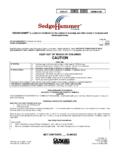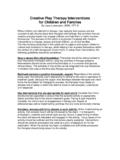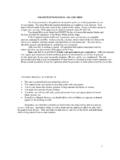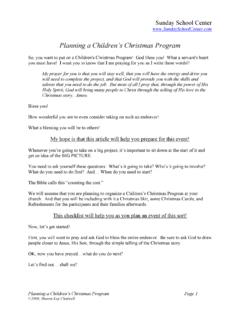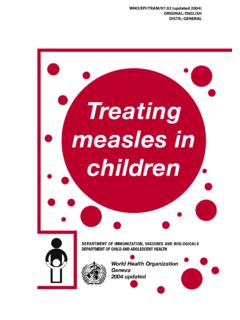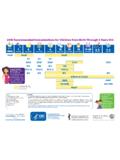Transcription of Complementary Feeding for Children Aged 6-23 …
1 $2 (8 )RRG )DFLOLW\ 3 URMHFW. Improve the Food Security of Farming Families Affected by Volatile Food Prices . To reduce the effects of volatile food prices, the European Union has provided financial support to the Food and Agriculture Organization of the United Nations (FAO) to help address the food insecurity in Cambodia. The FAO / European Union Food Facility Project focuses on the sustainability of increased productivity, improved management practices and improves access to agricultural inputs and services and to improve dietary diversity and family Feeding practices, starting with Infant and Young Child Feeding (IYCF). FAO has implemented the project in collaboration with the General Directorate of Agriculture of the Ministry of Agriculture, Forestry and Fisheries, with cooperation from Ministry of Women's Affairs, Ministry of Water Resources and Meteorology, Fisheries Administration, their relevant provincial departments and local non-government organizations.
2 The designations employed and the presentation of material in this information product do not imply the expression of any opinion whatsoever on the part of the Food and Agriculture Organization of the United Nations (FAO) concerning the legal or development status of any country, territory, city or area or of its authorities, or concerning the delimitation of its frontiers or boundaries. The mention of specific companies or products of manufacturers, whether or not these have been patented, does not imply that these have been endorsed or recommended by FAO in preference to others. The views expressed in this information product are those of the author(s) and do not necessarily reflect the views of FAO. All rights reserved. FAO encourages the reproduction and dissemination of material in this information product. Non-commercial uses will be authorized free of charge, upon request. Reproduction for resale or other commercial purposes, including educational purposes, may incur fees.
3 Applications for permission to reproduce or disseminate FAO copyright materials, and all queries concerning rights and licences, should be addressed by e-mail to or to the Chief, Publishing Policy and Support Branch, Office of Knowledge Exchange, Research and Extension, FAO, Viale delle Terme di Caracalla, 00153 Rome, Italy. FAO, JUNE 2011. $&.12:/('*(0(176. The nutrition messages and recipes in this book were developed, field-tested and refined in nine provinces (Kampong Speu, Takeo, Prey Veng, Svay Rieng, Kampong Thom, Preah Vihear, Banteay Meanchey, Siem Reap and Otdar Meanchey) by teams of officers from the Ministry of Women's Affairs, Ministry of Agriculture, Forestry and Fisheries, Ministry of Health, and the Food and Agriculture Organization of the United Nations (FAO). This book was produced by FAO in collaboration with the Ministry of Agriculture, Forestry and Fisheries, the Ministry of Women's Affairs and the Ministry of Health. National master trainers, provincial and district level staff from the three ministries were actively involved in nutrition training activities and facilitated the testing of nutrition recommendations and recipes in communities.)))
4 Our profound thanks go to the mothers and caregivers of Children who generously shared their knowledge and experiences L. and actively participated in preparing and tasting the Complementary foods. Our gratitude also goes to the local authorities in the nine provinces who facilitated introductions and supported the field work. Special thanks are due to the volunteers involved in the Trials of Improved Practices (TIPs) on Infant and Young Child Feeding , who helped to test this book and provided valuable comments and inputs. This book was produced under Project GCP/CMB/033/EC Improving Food Security of Farming Families Affected by Volatile Food Prices and would not have been possible without the financial contribution from the European Union. Contributors: Ellen Muehlhoff, Charity Dirorimwe, Shan Huang, Khin Meng Kheang, Ly Koung Ry Design and Layout: Nova Cambodia Photos: Khin Meng Kheang, Ly Koung Ry, Shan Huang 7$%/( 2) &217(176. $&.12:/('*(0(176 PAGE i ,1752'8&7,21 PAGE 1.))))
5 6(&7,21 6(&7,21 . What is Good Complementary Feeding ? Complementary Feeding Guide and Recipes PAGE 3 for Children 6-8 Months Old LL. PAGE 17. 6(&7,21 . Guide on Food Safety and Personal Hygiene 6(&7,21 . in Complementary Feeding Complementary Feeding Guide and Recipes PAGE 7 for Children 9 - 11 Months Old PAGE 25. 6(&7,21 . Guide to Food Preparation and 6(&7,21 . Household Measurements Complementary Feeding Guide and Recipes for Children 12 - 23 Months Old PAGE 11. PAGE 31. 7$%/( 2) &217(176. $&.12:/('*(0(176. 3+272. Photo 2, 3, 4, 6, 8, 9, 11, 12 (FAO/EU Food Facility Project). Photo 1, 5, 7, 10, 13 (National Nutrition Program). ),*85( LLL. Figure 1, 2, 7 (INVENT Cambodia). Figure 3, 4, 5, 6 (UNICEF). Figure 8, 9, 10, 11, 12, 15, 16, 17, 18, 19, 21, 22, 23, 24, 26, 27, 28, 29 (FAO/EU Food Facility Project). Figure 13, 14, 20, 25 (National Nutrition Program). ',$*5$0. Diagram 1 (FAO/EU Food Facility Project). ,1752'8&7,21. Purpose of the Booklet Seven out of 10 Children aged 6 months and over are fed plain rice porridge (borbor) with salt and sometimes a little sugar.))))))))))
6 Others receive plain rice with liquid part of soup. These foods fill the child's stomach but they do not provide enough energy and nutrients for good physical growth and mental development, often resulting in malnutrition. This recipe booklet gives guidance on how to prepare nutritious and safe Complementary foods for young Children . Recipe Development The Recipes in this booklet have been developed to meet the specific dietary needs of Children aged 6 to 23 months, using foods available in different provinces of Cambodia. Some of the foods are grown on family farms and home gardens and others can be purchased from the local market. The recipes were field-tested with mothers and caregivers in a real home setting to ensure that the foods are available and affordable to most families. Users of the Recipe Booklet 2 year Old The recipe booklet is for mothers, grandmothers and other caregivers who feed eed small Children . 1 year Old Contents of the guide 6 Months Old This booklet is organized in 6 sections which provide information and guidance nce on: Good Complementary Feeding .
7 Proper food and personal hygiene to prevent diarrhea. Appropriate food preparation methods and household measurements to ensure that Children get enough energy and nutrients nly i lk o a stm for growth and development. Bre Photo1. Complementary Feeding guide and recipes for Children of 1 Month Old (Source: National Nutrition Program). different age groups. Complementary Feeding 6(&7,21 . What is Good 6(&7,21 . What is Good Complementary Feeding ? Photo2. 6(&7,21 . What is Good Complementary Feeding ? The period of transition from exclusive breastfeeding to family foods, referred to as Complementary Feeding , covers a child from 6-23 months of age, and is a very vulnerable period. It is the time when malnutrition starts in many infants, contributing to the high prevalence of malnutrition in Children under two years of age. Malnutrition in young Children can be prevented by Feeding them enough nutritious and safe Complementary foods. Good Complementary Feeding means Feeding your child enriched borbor every day and offer additional nutritious snacks between meals, for example mashed ripe fruit.)))
8 You can prepare good enriched Borbor from a variety of local foods that are available in your home, from your garden or the local market. The diagram shows a wide variety of foods from which you can choose to make enriched borbor: Rice, sweet potato or taro Fish, meat, liver, egg or beans (peanut, mungbean). Vegetables such as morning glory, ivy gourd leaves, star gooseberry leaves (ngub), amaranth leaves, pumpkin squash or leaves, moringa leaves (marom) etc. Add a little oil to enhance the taste of food and to increase its energy content. 6 HFWLRQ . Wh at i s G o o d Co m p l e m e nt a r y Fe e d i n g ? Diagram 1 Chose one food item from each group to make different types of enriched borbor. ( Fish (5 Vary your child's diet every day. +. 520 Rice ) Your child will have more appetite, if you feed him/her ' . different foods daily. 22. 86. ). He/she will eat more and grow well. 1(. ( . Eggs Corn 21. 2. 86(. ( ). Taro Meat M eatt 22. Cassava Chicken C. ' )520 +(5(.))))
9 Yellow Sweet Potato Peanut . SSoya oy Beans /$5' . White Sugar Pumpkin Pumpk ump pk Seeds Tofu Palm Sugar 25 . Vegetable Oil Pumpkin P ki . Lard ,/. ( 2. Mung Beans Photo 3. $PDUDQWK. 86. ,Y\ JRXUG. 6 WDU . *RRVHEHUU\ . PRULQJD . Morning Glory OHDYHV. scooped ripe papaya scooped ripe mango pumpkin leaves 86. ( ( 2. +(5 1( )2. 2' )520 . Remember! Feed your child enough Borbor, and give different fruits every day. Your child will be strong, healthy and smart. and Personal Hygiene Guide on Food Safety 6(&7,21 . 6(&7,21 . Guide on Food Safety and Personal Hygiene in Complementary Feeding 6(&7,21 . Guide on Food Safety and Personal Hygiene in Complementary Feeding Practicing good food safety and personal hygiene is important for preparing safe and healthy Complementary foods and Feeding Children . It helps to prevent child illnesses, especially diarrhea. Therefore wash hands with soap (or ash) and clean water. Teach child to wash hands with soap and water :DVKLQJ . \RXU KDQGV.))))))
10 After cleaning Children 's bottom After using the toilet Figure 2. 5 HPHPEHU . 1 Use clean utensils to prepare and serve food Before preparing food Before Cooking 2 Select fresh or wholesome food 3 Reheat left-over food until hot Figure 1. and steaming 6 HFWLRQ . Guide on Food S a fet y and Personal Hygiene in Complementar y Feeding 1 2 3 Clean fingers and palms Pour clean water on both Rub soap on the palm hands and back part of the hands . *RRG KDQG ZDVKLQJ SUDFWLFH. Clean palms, fingernails and space between the fingers Dry with Rinse clean towel. both hands If you do not have a with clean clean towel, water simply shake water off your hands 4 5 6. Figure 3 (UNICEF). 6 HFWLRQ . Guide on Food S a fet y and Personal Hygiene in Complementar y Feeding . Cover your water jar Always drink safe water (From safe source or boiled). Figure 4 (UNICEF) Figure 5 (UNICEF). Always cover food Keep your home and surroundings clean Figure 6 (UNICEF) Figure 7. and Household Measurements Guide on Food Preparation 6(&7,21.)










